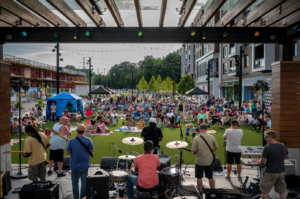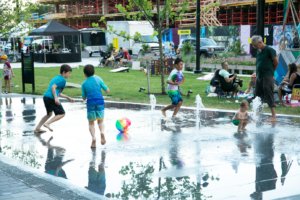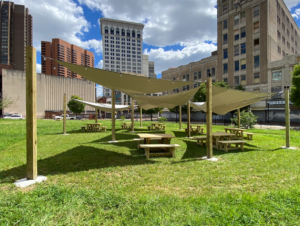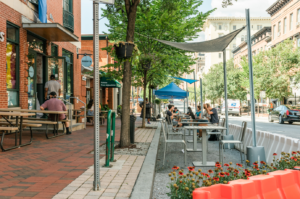Property owners see new opportunities in outdoor amenities
Go-go bands, yoga classes, poets and splash pads aren’t standard elements in a strategic plan for a real estate development. Yet on a former dirt parking lot in Downtown Columbia, they are attracting the public to a new mixed-use development and helping generate tenants for new buildings and customers for new retail sites.
One new reality of American life is more people want to spend more of their time outside. More than a mid-pandemic coping mechanism, this trend began well before 2020 and is expected to persist well after COVID-19 fades away. Yet the pandemic has shown us better design possibilities for outdoor spaces and the power of those spaces to change communities. Designers, developers, urban planners and others have seen how thoughtful outdoor spaces – from a new park in Columbia to al fresco dining in Baltimore – can improve quality of life, the success of businesses and the vibrancy of even struggling neighborhoods.

At Color Burst Park in Columbia, free concerts, yoga classes, poetry readings and other events are drawing crowds and tenants to a brand new neighborhood. Photos courtesy of Howard Hughes Corp.
“People eating and socializing outside creates a pretty lively atmosphere in the public realm that wouldn’t exist if everyone was indoors,” said Colin Tarbert, President and CEO of the Baltimore Development Corporation (BDC). “When activity spills out into the street, it creates vitality in commercial areas that otherwise might be fairly quiet. That can create more activity. People see other people having a good time and decide to join in.”
On that former dirt parking lot in Columbia, attractive outdoor amenities and programming “have been incredibly important because we are creating a new neighborhood,” said Greg Fitchitt, President, Columbia at The Howard Hughes Corporation. “Previously, this space was a dirt parking lot behind Merriweather Post Pavilion. It was hidden behind trees and power lines, so people generally didn’t know it was there.”
On a 22-acre site within the Merriweather District, Howard Hughes Corp. is developing 2.8 million square feet of mixed space, including more than 1 million square feet of office space in three towers, 1,100 new residential units, a new central library for Howard County and street-level retail throughout.
“But the centerpiece of all this development is the open space known as Color Burst Park,” Fitchitt said.

Color Burst Park’s splash pad proved so popular that Columbia residents convinced Howard Hughes Corp. to extend its hours. Photos courtesy of Howard Hughes Corp. and the Baltimore Development Corporation.
Tucked into the new-urban environment, the park offers visitors a variety of ‘rooms’, including an Astro-turf field, a performance space, splash pad, ice rink and sitting areas dotted with electric-blue Adirondack chairs. The space has proven to be a draw for families with small children and adults who want to meet up with friends or just get outside. Thoughtful programming on site has turned the former parking lot into a destination and a driver of both community life and economic development.
“We opened the ice rink last November. Even during COVID-19 with 50 percent capacity limits, we brought over 20,000 people to the ice rink,” said Vanessa Rodriguez, Vice President of Marketing at Howard Hughes Corp.
Outdoor fitness classes of 200-plus participants have consistently sold out, generating business for two companies that are moving into the area, F45 and YogaSix. Ironically, they have also generated robust after-class traffic to the area’s first retail tenant, the Charmery ice cream shop.
Meanwhile, free concerts in the park have attracted ample crowds and heightened awareness of the new development.
“The concert season was spectacular. One of the highlights was the D.C.-based go-go group Rare Essence performance. We were thrilled with the attendance. We had over 2,000 people in the park,” Rodriguez said. “Comments on social media afterwards were also spectacular. People talked about how great the Merriweather District is, how they had never been there before but they would be going back.”

Near the Bromo Arts and Culture District, the Design for Distancing competition produced The Meadow – a lush, green park that supports family outings, outdoor dining, pop-up shops, food trucks and the occasion opera performance. Photos courtesy of Howard Hughes Corp. and the Baltimore Development Corporation.
Early in the pandemic as small retailers and restaurants struggled to survive, the City of Baltimore launched the Design for Distancing competition. It challenged design professionals to develop concepts that would support businesses and residents in 18 neighborhood commercial districts, then funded the construction of multiple concepts.
On a vacant lot bordering both the Bromo Arts and Entertainment District and the Market Center district, a team lead by PI.KL Studio created “The Meadow” – an expansive green space with wildflowers, picnic tables, shade sails, lighting and a landscaped ‘mini amphi-theatre.’ In addition to creating needed green space in the city core, The Meadow created a place where residents would eat takeout from nearby restaurants, local businesses could stage pop-ups and entertainers could perform. This summer, it hosted performances by the Baltimore Rock Opera Society.
On 32nd Street, another design team created Waverly Commons – a community space with tables, bench seating and bright street painting. Area residents soon began reserving the Commons to host outdoor parties and Waverly Main Street organized a monthly concert series on site.
“The concert series has become really popular and it is driving traffic to nearby businesses. Two carryout restaurants in Waverly offer specials whenever there is a concert so people can pick up their food and go enjoy the music,” said Susan Yum, BDC Marketing Director.
At multiple sites around the city and beyond, commercial property owners and local governments enabled restaurants to expand to outdoor spaces.
“In an urban area especially, a lot of restaurants are relatively small so having the opportunity to expand beyond your interior footprint helped restaurants dramatically increase their revenue,” Tarbert said.

In Mount Vernon, the decision to convert portions of Charles and other streets into outdoor dining spaces enabled many restaurants to survive the pandemic and help create a vibrant neighborhood and business district. Photo courtesy of the Neighborhood Design Center.
Diners have grown increasingly interested in staying outside in wide ranges of weather. Consequently, restaurants and CRE companies are benefitting from investing in exterior spaces, said Brendan Gill, President of MacKenzie Management. “Some places have amazing pergolas that have built-in lighting, heaters and fans. Restaurants are benefitting from having more outdoor amenities and tables. Some are expanding their kitchens to support bigger output.”
Outdoor commerce and outdoor amenities could be a tool in revitalizing office and retail properties.
“Glen Burnie Town Center has recently struggled with vacancy and other aesthetic issues,” said Wes MacQuilliam, Business Development Associate at the Anne Arundel Economic Development Corporation.
The Northern Anne Arundel County Chamber of Commerce decided to tackle that situation by establishing a weekly farmers market onsite. With 43 vendors selling produce, hot sauce, pickles, fresh flowers, bread and gourmet foods, the market attracts 250 to 300 shoppers.
“The market has created a vibrant atmosphere and filled the Town Center with people who not only shop at the market, but also regularly patronize local shops and restaurants,” MacQuilliam said.